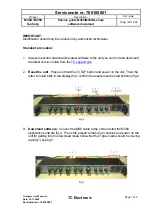
17
VOP1372G-61
Overview
The VOP1372G-61 line card is designed to install with IES-6000/5112/5106M.
VOP1372G-61 provides aggregated 72 lines of Plain Office Telephone Service toward
PSTN network. Each telephone line interface, Foreign Exchange Subscriber (FXS)
connected with subscriber’s telephone set through copper wire ranged up to 5km.
The analog voice signal from subscriber was converted to packet voice and
transmitted toward called party through packet network. FXS line card uses H.248
protocol for network signaling to establish a voice call. Advance call features like
‘three-party conference call’, ‘call forward”, “call waiting”, etc. are integrated in the
Media Gateway Controller (MGC) to make NGN migration become easy in access
network deployment and management. Besides, to consider simplify access network
convergence toward unified IP packet network, FXS line interface can co-exists with
deployed ADSL or VDSL service in the same paired copper wire without disturbing
each other.
Parameters
The VOP1372G-61 line card is different from other xDSL series line cards. Following
table display the novel attributes in VOP1372G-61 only. Operators should be careful
with these parameters while deploying VoIP.
Item
Description
IP
An unique ip address for VOP1372G-61
DNS
Specify the ip address of domain name server
Route
Define the default routing entry and gateway of routing
VoIP H248 profile
1. Setup the ip address/domain name of MGC (Media Gateway
Controller). The default port number is 2944 but can be customized
in both MGC and line card.
2. “Transport” can be “UDP” or “TCP”, it’s used in order to choose
the data transport method configured on the media gateway
controller.
3. “Encode” is used to choose the text encoding method configured
on MGC.
4. “802.1P” (0~7) and “dscp” (Differentiated Service Code Point,
0~63) are used to define the QoS in VLAN tag and IP header
respectively.
5. “Inactivity timer” is a keep-alive timer from the MG to MGC. If
















































